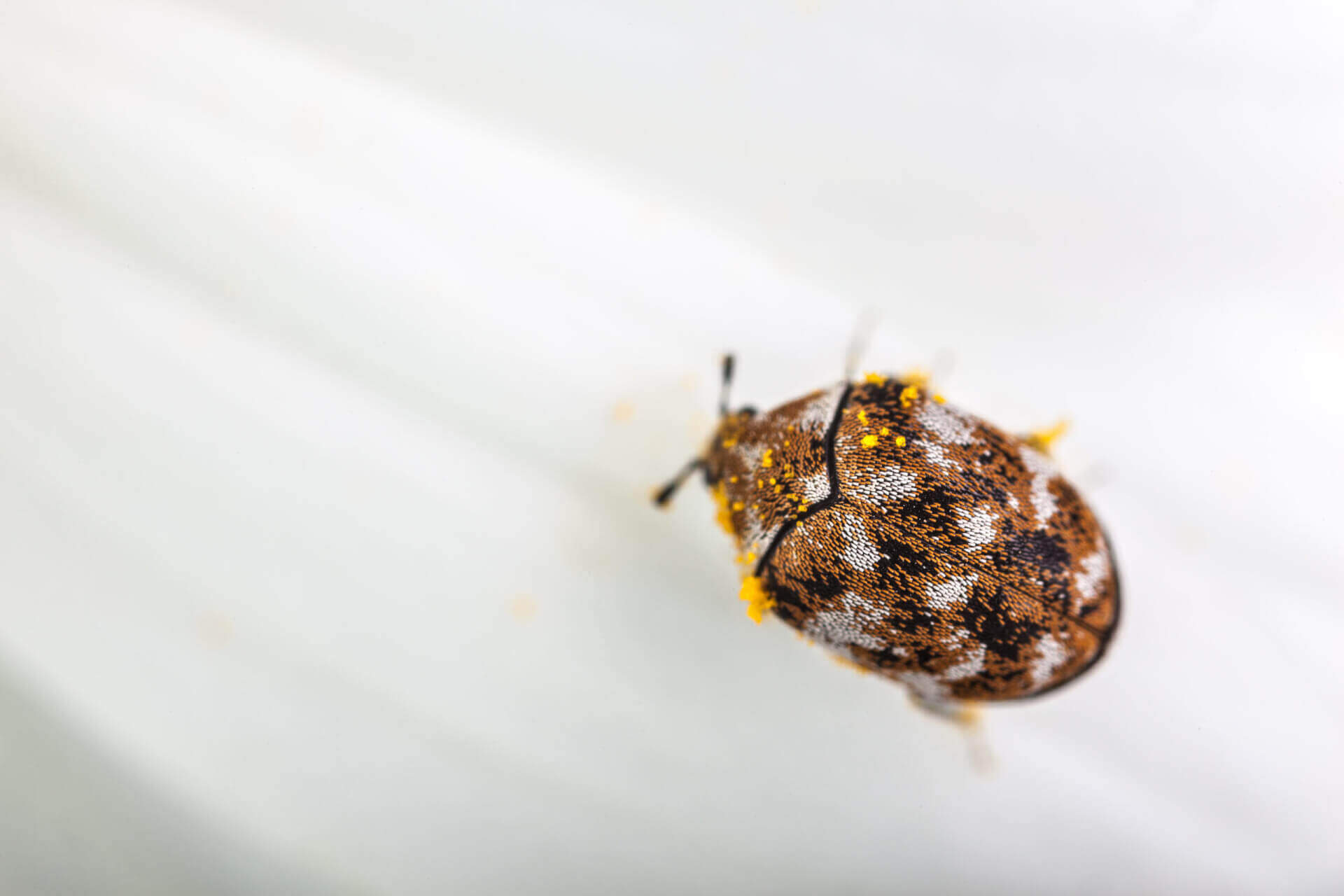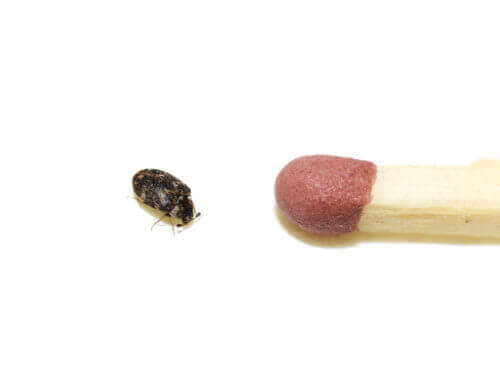Carpet Beetle Facts & Information
Everything you need to know about carpet beetles
What do carpet beetles look like

Carpet beetles like to congregate in areas away from human activity. Adult carpet beetles can grow up to 1/8 inch long and range from black coloring to patterns of white, brown, yellow, and orange. The adults feed on flower pollen and are typically transferred indoors during the spring. Female beetles can lay between 50-100 eggs on or near vulnerable materials, though breeding grounds can vary depending on the environment. Eggs can be laid on fabric items stored in the back of a closet, areas where pet hair congregates, or even on taxidermy. Carpet beetle larvae will not feed on synthetic fibers and primarily feed in spaces that are dark and undisturbed.
Adult carpet beetles are attracted to light, so finding them around a windowsill is a good indication that there may be an infestation. When hunting for carpet beetle larvae, look for large areas of damage on garments, carpet, upholstered furniture, or other similar items. The larvae can grow up to the size of adult carpet beetles and are a tan-brown color. They are slow moving and densely covered with hairs or bristles. Carpet beetle larvae will leave behind molted skins and fecal pellets as they develop. In their adult phase, carpet beetles can live between four to eight weeks.
Adult carpet beetles are attracted to light, so finding them around a windowsill is a good indication that there may be an infestation. When hunting for carpet beetle larvae, look for large areas of damage on garments, carpet, upholstered furniture, or other similar items. The larvae can grow up to the size of adult carpet beetles and are a tan-brown color. They are slow moving and densely covered with hairs or bristles. Carpet beetle larvae will leave behind molted skins and fecal pellets as they develop. In their adult phase, carpet beetles can live between four to eight weeks.

Because of their small frame and shape, other insects can be mistaken for carpet beetles (and vice versa). Carpet beetles resemble other nuisance pests like bedbugs and lady beetles (a.k.a. ladybugs) at first glance. When spotting any of these look-alikes, it’s important to make an accurate determination of the species so you can use the appropriate treatment method.
Though they feed on the same items as clothes moths, carpet beetles can do more severe damage. Carpet beetle larvae typically feed on a large area of one portion of a garment or carpet while moth damage is more likely to appear as scattered holes. Clothes moths typically build webs and carpet beetles do not.Not the beetle you have?
Though they feed on the same items as clothes moths, carpet beetles can do more severe damage. Carpet beetle larvae typically feed on a large area of one portion of a garment or carpet while moth damage is more likely to appear as scattered holes. Clothes moths typically build webs and carpet beetles do not.Not the beetle you have?
How Did I Get Carpet Beetles
Carpet beetles can enter the home through an open door or window or on an item which is already infested when it is brought inside – like an item of furniture, a plant, or on fur. Taxidermy animals are also a popular hotspot for carpet beetles. Adults like fabric and animal products so they usually fly in through open windows and lay larvae on furniture, clothes, rugs, and, of course, carpets. If left alone and the area is not kept clean and sanitized, carpet beetles can easily thrive in your home. That’s why carpet beetle control is so important.
What Problems Do Carpet Beetles Cause
Adult carpet beetles feed on pollen from flowers, while the larvae can feed on anything from silk to fur to leather and even pantry items leaving holes behind. The larvae can even irritate your skin with their bristly hair. The adult carpet beetles don’t feed on your fabric, but if you have adults, the eggs and larvae are probably somewhere in your house or business, too. They will lay their eggs on rugs, clothing, or furniture and the larvae will eat their way out – doing the most damage. That’s why proper identification is necessary so we can provide the correct carpet beetle treatments for ultimate carpet beetle control.
How Do I Get Rid of Carpet Beetles
Carpet beetle larvae like to feed on debris in the carpet, including dead skin, dead insects, and hair (both human and pet). Vacuuming regularly will mean there is less for the carpet beetles to feed on. You will also vacuum up larvae and eggs. Pay particular attention to the carpet along the skirting boards. Much like vacuuming, steam cleaning hard surfaces will help deal with carpet beetles. The heat and moisture removes remaining beetles and eggs. Wiping or spraying surfaces with vinegar is another tip for getting rid of carpet beetles. Wipe surfaces, window sills, shelves, drawers, and hangers with a vinegar mix. You’ll want to ensure any dirt or food residue is regularly cleaned up as well, which will help with more than just carpet beetles. Clean infected areas thoroughly to remove the larvae and any debris. Ensure surfaces, furniture, and soft furnishings are regularly wiped down or laundered.
Be careful using over the counter pest control products. When used improperly, they can be toxic and oftentimes will only force the carpet beetles to either move to another room or find a better hiding spot. Those things are better left to a professional exterminator.
Be careful using over the counter pest control products. When used improperly, they can be toxic and oftentimes will only force the carpet beetles to either move to another room or find a better hiding spot. Those things are better left to a professional exterminator.
Why Waltham for Carpet Beetle Control
We’re passionate about keeping carpet beetles out of your home or business because we live and work here – it’s our neighborhood, too. With our 130 years of experience keeping homes and businesses in Massachusetts, Connecticut, New York, Maine, Vermont, New Hampshire, and Rhode Island safe from pests, Waltham has the experience you can trust.
Satisfaction Guarantee
24-Hour Guaranteed Response
Board Certified Entomologists
Say goodbye to carpet beetles.
GET MY QUOTE
“Exceptional service. Prompt and professional. Used for both business and home. Very efficient and honest.”
Agawan, MA
